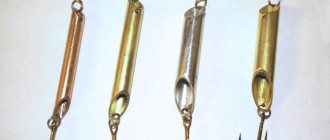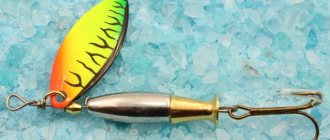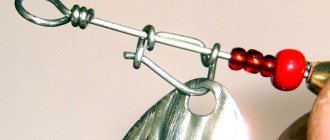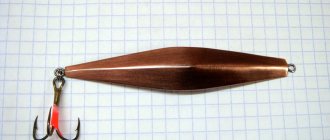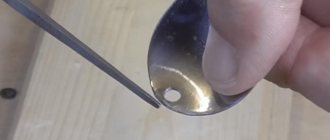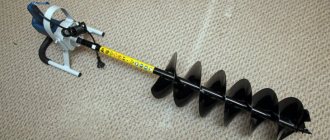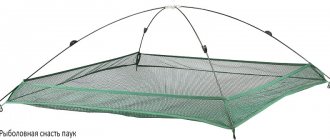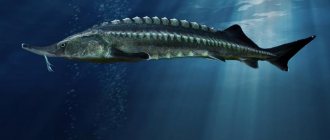Alexander Prokofiev about the spinner. Vadim MATSNEV
Alexander Prokofiev – design engineer Photo: Vadim MATSNEV
In an interview with Channel One and the Associated Press agency, Vladimir Putin “advertised” the manufacturer of the spoon with which he recently caught a 21-kilogram pike, the largest in his life: “By the way, I caught it with a small spoon that he produces I think it’s a small family enterprise in Krasnoyarsk, it’s called “Tsar Fish”. I specially took a photo and wanted to send it to the manufacturers of this spoon, but I still don’t have time. But I hope that I will do it."
In fact, now the Krasnoyarsk spoon is no less famous than the Tuvan pike: its author’s phone rings off the hook every day. Alexander Prokofiev accepts congratulations and... new orders.
By profession, Alexander Prokofiev is a design engineer; he lived in Norilsk for many years, and after retiring, he became seriously interested in improving spinners, especially since fishing is his favorite hobby. He told Komsomolskaya Pravda the secrets of his know-how.
In a conversation with me, Alexander Petrovich sighs all the time and selects his words:
- You’re a girl, how can I explain it to you... In general, I studied French, American, Swedish lures. I left all the pros and improved them, but reduced the cons to nothing. The peculiarity of this particular spinner, which has now thundered throughout the world, is the noisy “provoking” core.
The President caught a pike with a small spoon produced by a small enterprise in Krasnoyarsk Photo: Vadim MATSNEV
The lure also has a metal water whistle (by the way, it also whistles for your sweet soul in the air). All these noises that the spinner creates as a whole really cannot leave predatory fish indifferent. Even if there is no bite (the pike just stands in the water and guards its prey), it does not pay attention to the small fish. But this lure will definitely irritate her, the predatory reflex is triggered, and she rushes at it. Plus the materials themselves. They create a certain field, which is probably similar to what is emitted by the usual pike prey.
- Why didn’t anyone bite that time, but Putin cast a fishing rod - and immediately luck, and what kind of luck?
“Next to him was an experienced huntsman who has been using my lures for several years now. Apparently, he advised the president to try it. And here is the effect. For me there is nothing surprising here at all. I double-check and test my spinners. They all work. Even when there is no bite, when other baits are useless.
And indeed it is. The fish takes the bait. And what a one! Alexander Petrovich’s personal record is taimen weighing 45 kilograms!
“I caught him five years ago.” And not in Tuva, by the way, but on the Yenisei, at the 120th kilometer, there is a place where the river shipping company is located.
Prokofiev fished in Tuva more than once.
— There is a good river called Bash-Khem, I also recommend Khamsara. In our region there is excellent fishing on the Lower and Podkamennaya Tunguska.
A rare occasion - a shoemaker with boots, fishing - with his lure, at the same time you can do tests while developing models. A small, almost family-owned enterprise, with the wife always nearby, both at work and fishing, has been in existence for 9 years. Now the Krasnoyarsk spinner is known abroad.
“The Chinese have already learned to counterfeit,” Alexander Petrovich laughs. – And an international patent is very expensive.
EXPERT OPINION
Boris Eremeev, professional fisherman, author of practical guides on fishing, inventor of spinners, decoys (Krasnoyarsk):
“I’ve known Petrovich for many years, he’s a good man!” (laughs). The secret of his spinners is that he tests everything himself. He does - and stays, tries, tries... If he doesn’t go, he changes, improves something. He looks at what the fish are doing. This is a delicate matter. Spinner, bait for fish, is an irritant. And the one she couldn’t calmly swim past did well. Well, plus one more thing, his spoons are made taking into account all the features of Siberian fishing. It worked!
Spinner "Tsar Fish" and its wide popularity
A large amount of information about the Tsar Fish lure has appeared on the Internet. What is she? What brought her such great popularity?
The Tsar Fish spinner was practically unknown among fishermen. Only a small number of people from Krasnoyarsk who are interested in fishing knew about its existence. One incident brought popularity and worldwide fame to the lure. This event occurred in July 2013, when the head of the Russian state went on vacation. A place where one could escape from the bustle of the city was chosen that was rarely visited - in the Tuva region. There is a picturesque lake nearby, where Vladimir Putin decided to go fishing with a spinning rod.
The spoon used for this was made by a local craftsman. And it met all expectations - a fish weighing 21 kg bit on it! These were the most exciting minutes the president spent fishing, since he had never come across such impressive specimens before.
After gutting the fish, it became clear that she was not hungry, but rushed to the bait only because she was very attracted to it by its appearance.
Who gets caught? 3 predators that cannot resist this homemade product!
Good day, friends. I want to tell you an interesting story about fishing on liquid water. After all, March will come soon, then April, and then we’ll get the spinning rods. Wow, how I miss casting. And probably you too!
However, we will talk about a spinner, which can also be used for fishing with vertical fishing, that is, in winter. You won’t believe how an ordinary nut sometimes catches legendary mepps and other tins that cost the fisherman far from a pretty penny.
That evening I firmly decided that I needed to prepare a modest set of spinners from nuts of different weights. Chromed and regular, painted. But after I spent one of them in the bath, I realized the peculiarity of this homemade product. It was precisely in the game, or rather in its complete absence. But the gurgles that formed during movement were amazing.
The incident happened in the fall. We were fishing on the lake and trying to catch a pike. Wobblers, jigs and regular spoons were not successful. Suddenly, out of hopelessness, I decided to try fishing with a nut. I saw her in my fishing shmurdyak.
Of course, there were no holes. I had to cling to the leash, with a little trick. To be honest, I didn’t hope for anything. And in vain, because literally from the 3rd wiring step a small pike landed on the tee. Next I saw more tails from the heels, they were all released back, growing up. How to make a spinner out of a nut?
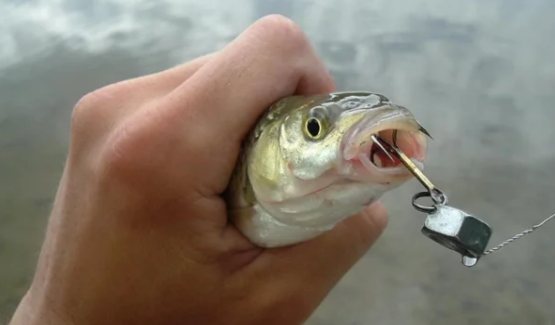
That evening I firmly decided that I needed to prepare a modest set of spinners from nuts of different weights. Chromed and regular, painted. But after I spent one of them in the bath, I realized the peculiarity of this homemade product. It was precisely in the game, or rather in its complete absence. But the gurgles that formed during movement were amazing.
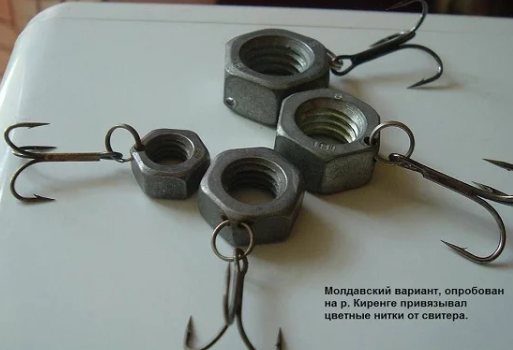
In the end, I just drilled two holes in the nut for the winding rings and tee and the job was done. Since then, such homemade products have always been in my drawer and sometimes pleasantly surprise me. No, this is not a panacea for bitinglessness. The nut is a cheap tackle that can bring results when everything else is silent!
Who is caught with a lure made from a nut?
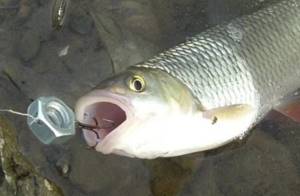
I don’t have a complete list of people who want to try a piece of iron. However, according to my personal observations, the following lures will definitely be tempted by: pike, pike perch and asp, which I caught during the trip. For perch you need to try a smaller nut, I wonder what will come of it? Maybe someone has already tried it?
YandexGen
Similar articles:
About the main thing → From July 1, Astrakhan residents began to receive new “children’s” 10 thousand
About the main thing → 40 new cases and the coefficient is above one. New data on COVID-19 in the Astrakhan region
About fishing → The famous Astrakhan festival “Vobla” is postponed to September
About the main thing → The simplified procedure for registering pensions and social benefits has been extended. The main thing you need to know
Women's Club → 6 clever ways to make a man bored
How it all began with Alexander Petrovich
A previously little-known fishing enthusiast, Prokofiev Alexander Petrovich, after retiring, decided to devote more time to his hobby. After all, fishing was his hobby from early childhood. But in stores he found only imported samples of baits. This upset him somewhat, and he decided to create his own successful version of the spinner. After studying the properties and characteristics of foreign baits, he moved on to creating his own. His knowledge of engineering helped him a lot in this.
After some time, the Tsar Fish pike lure saw the light. The inventor lived on the banks of a river, so he carried out all the tests in an open body of water. After all, it is so important when creating a spinner to pay great attention to all the nuances: the placement of the center of gravity, shape, design.
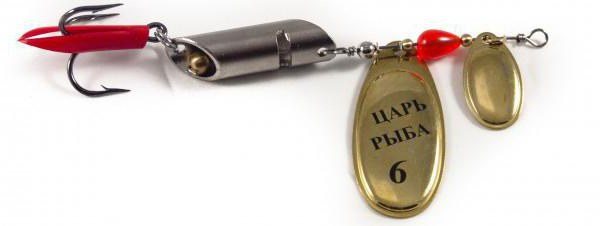
After testing the bait by Alexander Petrovich himself, friends and acquaintances began testing it. The spinner impressed many people, became in demand, and the inventor’s wife also joined its production.
At first, the Tsar Fish spinner was made right in Alexander Petrovich’s apartment. Later, a small machine for the production of spinners was made. After which their production became the family business of the Prokofiev family.
Characteristics of the Tsar Fish spinner
The Tsar Fish spinner is something between a spinner and a castmaster. There are also some tricks in creation, which the master, by the way, happily divulges and does not keep secret.
So, to create a bait, a string is used, from which the first loop is made, called the top one. After which the petal and fairing are put on the string. Then the casmaster is attached. It has a distinctive hole that acts like a whistle. And thanks to the presence of a special bell, additional noise is created when the spinner is held under water. This sound attracts fish very much. The tee is attached to the body of the spinner using the well-known winding ring. These are all the tricks that are used when creating bait.
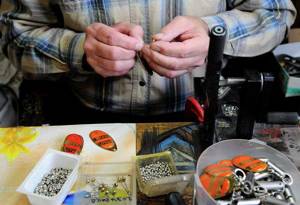
The Tsar Fish spinner takes three minutes to assemble. Before this, it takes some time to prepare the components. By the way, each product has a name on the petal.
- Creation of an electric field using a galvanic couple
- Distance between components
- EMF selection
- Pike spoon
- How to increase the electrical potential of a spinner?
- Lure designs
Part 6 Bipolar spinners
Creation of an electric field using a galvanic couple
As a preface, it should be noted that the data presented in the article have long ago outgrown the framework of a naive discussion with a series of timid proposals, unconvincing arguments, or simply philistine rumors.
The practical benefits and effectiveness of using baits that have the necessary electric field have been tested many times in practice and are so obvious that only a person far from fishing can ignore them.
The fish can be interested in the game of the bait, its colors, light pulses, sound effect... And the catch is very successful. But if the spinner does not have an electric field that imitates the bioelectric potential of a small fish or, more precisely, the intended target of a predator, then no matter how great its game is and no matter what other advantages the bait has, it will never be consistently catchy.
Rare contradictory publications about the electropotential of fish and mysterious electric baits arouse genuine interest among most readers from year to year. We can even say with confidence that a situation has arisen in which it is impossible to know more. The reader either stumbles upon a bashful silence of the question, or a polite aside. The lack of intelligible materials on this topic is also quite understandable - this problem is complex and multifaceted, requiring not only certain special knowledge, a systematic approach, but also numerous experiments, which are quite difficult to carry out in fishing conditions.
It is long overdue to clarify this issue by considering it, to the best of our ability, step by step and comprehensively.
The fact that fish, like all living things on Earth, create and generate an electric field around themselves is a well-known fact. Without going into details, we can say that fish create electric fields as a result of moving in a high-density environment, which is water, and also due to the constant work of the gill muscles (this is a classic case when mechanical energy turns into electrical energy).
Each fish, regardless of its type and size, forms its own individual bioelectric field. This is a kind of calling card for representatives of the underwater world. It is thanks to it that fish recognize live food, which also has an electric field, learn about the presence of other fish, and pick up a signal of danger (for example, if a specimen with a stronger bioelectric potential approaches). The predator unmistakably distinguishes a sick fish from a healthy one by the configuration of the field, and begins to pursue only it.
Obviously, about 150 years ago, using a galvanic couple to create an electric field for baits in fresh water was quite difficult, since the electrical conductivity of clean river or lake water is negligible. Now, when litmus paper reacts even to snow melting in the mountains, modulating a weak electric field using a galvanic couple is not the most difficult task. Another thing is that it is very difficult, and in many cases impossible, to give a specific answer to the question: what is the qualitative and quantitative influence of artificially created bait fields on the bioelectric fields of various fish or, more simply put, on biting activity?
If similar experiments are carried out at the appropriate laboratory research base, the source material for at least two dissertations will be obtained. For a long time, I didn’t really believe in the superpowers of electric baits consisting of different metals, believing that the greatest effect occurs due to the different colors of spinners or jigs. And only after testing more than a hundred spinners of various designs, both spinning and for vertical fishing, made using different technologies and consisting of a combination of different metals, I came to the conclusion that the effect of a weak electric field is unique and irreplaceable. To be honest, after several years of experiments (individual lures were manufactured more than 15 years ago), I received results that I could have come to immediately by recalling information in my memory, for example, from the second volume of a textbook on elementary physics edited by Landsberg (chapter 6 “Chemical and thermal current generators"). The theory of the experiment in it is designed, as it were, specifically for the inquisitive, but not entirely competent fisherman (the shortest path to the truth is the destiny of not many). I was even more surprised that such widespread literacy is inherent in almost all spinning players around me, both in our country and abroad (having a higher education, or even an academic degree, did not play a role).
I don’t want to seem to anyone like an alien who thinks in other categories, or, on the contrary, like a complete amateur, fooling pundits with truisms, but since not everyone loves physics and didn’t take it yesterday, we should talk about childhood mistakes in making spinners. This conversation is necessary in order to somehow prevent the waste of time and useless experiments of individual fishermen.
Distance between components
Due to the fact that water is still a very weak electrolyte, the distance between the components of the spoon ranges from 0.05 to 0.15 mm, which in practice is comparable to the usual superposition of one sphere on another and a slight displacement of one of the planes by 1.5–3 mm in length. The plane of one of the surfaces protruding beyond the dimensions is ground down manually or on a wheel. It is also possible to install strips or simply pieces of similar material of the required thickness between the halves. However, for the spinner to work effectively, it is enough that in one or several places the surfaces are separated from each other by the specified distance.
EMF selection
The emf of a galvanic pair is always determined by the formula E = [e1-e2], where are the electrode potentials, and the smaller one is subtracted from the larger one. In principle, this method of determining EMF is 100% suitable only for pure metals. The highest EMF value is observed for the zinc-copper pair and is equal to 1.1 V (for comparison, for the iron-lead pair it is only 0.31 V). Very often, pairs composed of alloys of active metals are so ineffective, and, one might say, even useless (a typical example is most zinc alloys), that it is simply incorrect to refer to this formula. But nevertheless, pure, rarely found elements should not be mined by hook or by crook, since it is quite possible to get by with a combination of more accessible metals and well-chosen alloys.
The digital value of EMF should not be approached purely arithmetically, according to the principle - the greater the EMF and the electric field of the bait, the more noticeable the effect that seduces predatory fish. Ideally, the electric field of the spinner should match or be very similar to the field of the fish that it imitates, no less and no more. And even better if it matches the field of the sick fish.
Talking about the abstract meaning of EMF and not linking it with the actual data obtained while fishing is empty. Thus, when testing baits, it became clear that it is extremely difficult to make a spoon with a universal electric field that equally attracts the majority of predatory fish. This can be seen especially clearly in the example of pike fishing.
Pike spoon
In most cases, pike prefer baits with a noticeable EMF value. For the manufacture of such spinners, the best materials are blanks made of copper, brass and steel 10, 20, 30, 45 without galvanic coating (combinations of precious metals are not considered).
Less carbon metals rust too quickly, and many alloys, composed of chemically neutral metals, colloquially called stainless steel, practically do not react electrochemically with other metals and water. There is nothing wrong with the fact that metal corrodes or simply rusts. The fisherman needs catchy lures, not eternal ones (two-piece “spinning spoons” usually last for decades and disappear only after being hooked or meeting pike teeth). The main thing is that the combination, or more precisely the choice of plates, brings the desired effect. As a result of experiments, it was revealed that an average oscillating spoon weighing 10–12 g without a strong bend, and therefore not having a large drag, which usually imitates a fish up to 100 g, should have a total EMF value of at least 0.55 V and up to maximum values that can be obtained by combining with different galvanic couples (data obtained as a result of numerous, practical experiments, tabular values and an already known formula).
Pike almost always reacts with interest to any amount and location of microEMF. When making pike spinners, it is necessary to take into account that with their electric field they imitate large baitfish weighing from 70 to 150 g. In this case, the spinner should be at least 10–15 cm long and, with a given wiring, cause strong turbulence in water flows, but if it is small or even an average rotating spoon weighing up to 5–10 g creates too strong an electric field, sharply different from the intended object of the hunt; the predator reacts reluctantly to such bait, quickly recognizing the catch. And yet, if a fisherman comes fishing with only spoons with a strong electrical potential, and the pike that day prefers small things, he is not guaranteed a catch.
The conclusion is:
1. Pike more often reacts to bait with a strong electric field, but the choice of spoon also depends on the size of the fish that the predator is hunting at the moment of fishing.
2. Large specimens are almost always caught with a bait with a stronger electrical potential and the appropriate size of the spinner.
In practice, it looks like this: you’ve worn out the “pencils” in the coastal zone, you put a spinner with a stronger electrical potential, and out of nowhere, almost at the behest of a pike, more worthy specimens appear even in such an unpromising place.
In no case should the question be viewed simplistically and assume that the spinner may not have other properties that have a positive effect on biting activity, and that they can be safely neglected (without good play, the spinner is a piece of iron). Of course not. And yet, the conclusion suggests itself: in most cases, pike react reluctantly to a spinner with a weak electrical potential.
How to increase the electrical potential of a spinner?
Despite the fact that the EMF of a particular galvanic pair is determined only by the selection of metals and electrolytes (in our case, only metals) and does not depend on the area of the plates or electrodes, it is quite possible to simulate the electric field by increasing the electric current.
The effect is achieved by placing a large number of fragments of another metal in the metal body of the spinner, forming identical galvanic pairs with it, that is, increasing the area of the boundary contact.
To some extent, with a large amount of EMF, it is even possible to talk about the noise effect of baits, although in this case there is also a side effect: the stronger the current, the more intense the corrosion occurs (the electrochemical reaction in such spoons is very violent, so after fishing they must be removed only wipe dry, but also periodically clean the surface from formed oxides). One day I decided to tie up an electric spoon after it had been removed from a pike’s mouth, and in the heat of the moment I began to bite off the fishing line with my teeth and accidentally touched it with my tongue. The effect was the same as touching the terminals of a slightly discharged coin cell battery.
Lure designs
For closed reservoirs of Central Russia, all baits can be conditionally divided into pike baits with significant electrical potential and for catching other predatory fish, in particular pike perch. The galvanic pair for such spinners is selected based on the fact that the EMF arising during their interaction rarely exceeds 0.5–0.6 V. It is quite acceptable to call such spinners universal, suitable for all predatory fish. A schematic representation and general principles for the manufacture of baits that have electrical potential and have proven themselves in practice are shown in Fig.
96–105. Rice. 96. Fastening the components of the spoon with rivets: – options for installing rivets Fig. 97. The components of the spoon are glued together: Options for applying glue to the surface of the spoon Fig. 98. Cold pressing (insertion) of one metal into a spinner blank of another Fig. 99. Point pressing of rods of one metal into the workpiece of a spinner of another according to given profiles: – options for placing rods in the body Fig. 100. Electric spot welding - welding points in composite spoons Fig. 101. Installation of rivets of one metal into the spinner blank of another: – location of the rivets in the spinner Fig. 102. Fastening the overhead surfaces to the plane of the spoon workpiece using rivets or rods: – options for fastening the overhead surfaces of the spoon Fig. 103. Installation of rivets or rods of one metal into a workpiece of another: – options for the location of rivets or rods in the lure Fig.
104. Threading a wire of one metal through holes in the plane of another: - options for placing the wire according to a given pattern In rotating spinners, the effect of an electric field is observed if the petal, core and equipment are made of two active metals that form galvanic pairs with each other. The design of a spinner with a two-part petal or a petal with inserts made of another metal, as a rule, leads to its weighting and therefore has several disadvantages: weak rotation of the petal, its numerous failures and sticking during wiring, and if this can still be avoided, then a “rotator” with a weighted petal it still has an inexpressive game and is of little use for fishing.
For pike perch, the best combination of metals in a galvanic pair looks like this: frame - nichrome, core and turntable equipment - copper and brass. For pike – steel-copper (steel without coating).
Despite the fact that a galvanic pair may consist only of a spinner's winding or soldered ring, branded swivels and winding rings, due to the protective coating applied to them by galvanic means, in most cases remain neutral and do not react with water and other metals.
When placing the EMF in the body of the bait, you obviously need to focus on the fact that the strongest bundle of electric lines in a fish is located around the head and from the spine, below the dorsal fin, to the tail (Fig. 106).
Rice.
106. Conventional arrangement of electric lines around a fish For a spinner that has an electric field, drawing an extra eye or sticking a holographic image on it is childish pranks. The predator will always attack that part of the bait in which the EMF is greater (for fish this is the head area). In spoons intended for vertical trolling, the galvanic pair is always located closer to the tee (Fig. 107).
In Devons - usually in the middle of the bait
(Fig. 108). Rice. 107. Composite spoon for catching pike perch using the vertical lure method with a galvanic pair located in the tee area Fig.
108. Devon, consisting of two different metals Contents
How does the spinner behave when retrieved?
When fishing, the Tsar Fish spinner behaves quite noisily underwater. This can be seen by the vibrations of the rod tip. With its help, a powerful vibration is created, which attracts the attention of the fish and arouses interest. Thanks to this, Alexander Petrovich managed to catch a fish weighing 45 kilograms with his bait.
The master makes baits of different sizes. The President of the Russian Federation caught a pike using the largest spinner of the entire line. Among foreign manufacturers it is quite difficult to find a spinner of this size.

The inventor does not seek to patent his invention. He keeps all his best specimens and puts them on public display at presentations of fishing equipment.
The Tsar Fish spinner received its name during a meeting of the fishing club, where lovers of quiet hunting, through discussions, selected the most appropriate names for baits.
Reviews of the Tsar Fish lure
Thanks to the feedback from fishermen and specialists, we can draw some conclusions about the described bait. These lures are catchy, since their inventor tests everything himself, and if anything does not spin as it should, the bait is remade. The Tsar Fish spinner, which has only rave reviews, is unique in its design.

True, some fishermen note its high cost. If the reservoir is snagy, then with significant snags and cliffs, fishing will hit your pocket hard. But many amateurs liked spinners, and they enjoy fishing with them. How many people, so many opinions. One thing can be said that the work of the inventor of the Tsar Fish spinner is worthy of respect and recognition.
Maniacs are the best micro turntables!
Date: October 5, 2015 | 695
Maniacs are magnificent hand-made ultra-light rotating spoons. These turntables are very well known in Ukraine, as well as abroad. The level of the brilliant products of the Kyiv master was appreciated in Russia, and in Belarus, and in the Baltic states and, probably, in many other places. I have already written several separate articles about these spoons, and in many reports and articles, I mentioned them in passing. Well, I’ve been fishing with Maniacs for 5 seasons now. I think they deserve another review!
You know, I have fished with a variety of rotating spoons in my practice. On turntables, both from well-known companies, and from not so well-known ones, and from master craftsmen and artisans. And you know, against Maniacs spinners... Everyone else smokes very heavily, relaxes, etc.
Optimal materials (stainless wire, non-ferrous metals), moderately heavy core, perfect execution, excellent repeatability of patterns (as for handmade), classic color palette (silver, gold, copper, matte black), matte surfaces of the petals, variety of sizes, instant petal plant, excellent work in a variety of conditions, sharpest tees, neat front sight.
Mepps are legendary and good. Blue Fox are also famous and wonderful. Murans, Pontoons, Panthers, Vyunovki... Excellent lures, they catch. But... And I can’t even dare say that at least one model, at least from anyone, is better than a Maniac of a similar class.
Maniacek's weight is quite serious when compared with models of similar size. There are, of course, special weighted models, or turntables such as Myuran. So, Maniacs occupy an intermediate position. They are both heavier than similar models and lighter than weighted versions. So, you can throw the Maniac far enough, and in a fairly fast current it is not so thrown up. Very easy petal plant, instant plant! This is the best plant in any conditions. And this is perhaps one of the key features of these spinners.
Another key feature of the Maniac is the excellent, easy rotation of the blade when retrieving at very low speeds and when retrieving in bodies of water with current. Even in flows where jets meet with noticeably different speeds.
The sharpest tee, an attractive front sight, a matte, low-glare surface are just pleasant bonuses. But, also, very important ones who understand.
Do Maniacs have any disadvantages?! Well, if you really strain yourself, you can only express one regret that these turntables are presented only in the ultralight and light ranges. Still, the maximum weight is 5g, this and that, for one model and about 3g for several more - this is not enough. Well, the key advantages of Maniacs are especially critical and acute in the UL range. So, we have what we have.
Now let's go through the Maniac models.
"Polyglot"

Polyglot is a pinwheel with a petal of the classic narrow “willow leaf” shape. Such spinners are traditionally used when fishing in the current. You can, of course, successfully use them in stagnant reservoirs, but, nevertheless, it is optimal to use spinners like Willow Leaf in rivers. The closest thing to the Polyglot Maniacs are the Mepps Longue spinners. In the ultralight range, let's face it, Mepps loses a lot. The weight is less, the winding speed is not so enchanting, the tee is noticeably dumber. The largest version of the Polyglot weighs 5g, closest in size to Mepps Longue No. 1. The French petal is slightly larger and weighs 4.5g. A very good spinner, but, according to the characteristics indicated in the first part of the review, it is inferior to the Maniac Polyglot.
Polyglot is available in four sizes: 1g, 2g, 2.8g, 5g. Three pure ultralights and a 5 gram version, already quite included in the light range.
“Gedz”
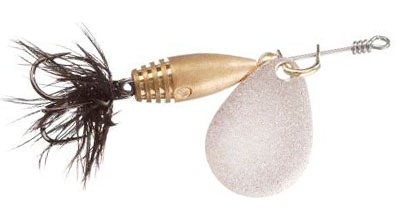
Gedz is a spinner with a practically round petal, the ideological opposite of the Polyglot. Designed primarily for fishing in calm water, without a pronounced current. On rivers it is used only when casting upstream. This is especially true in fast sections, when, in order to start a spinner with a narrow blade, you have to drive it too quickly. Under these conditions, the wide petal starts up noticeably earlier and at a lower speed. It's valuable.
The closest analogue is Mepps Aglia spinners and the like. But the general advantages of Maniacs, which I mentioned in relation to Long, remain here. Heavier core, better plant efficiency.
Gedz is represented by a very wide range of standard sizes: 1g, 1.5g, 2.1g, 3.3g.
“Dogmatics”
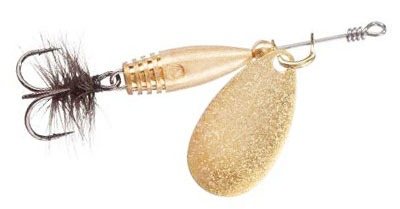
Dogmatika is a pinwheel with a petal of medium width. Classics and universalism in the most selective quality! In general, this is my favorite model among the Maniacs. Yes, and in general, I like spinners with this petal shape. Previously, before I became acquainted with Dogmatika, I used Mepps Comet on Olympus. This form is very good. With such a spoon you can fish very successfully both in areas of calm water and in noticeable currents.
The Dogmatika spinner is also available in three weights: 1.4g, 2.1g, 3g.
From my experience, Dogmatika is one of the record-breaking lures that has collected a large number of fish of different species. Only the next model is slightly superior to it, for now...
"Rebus"
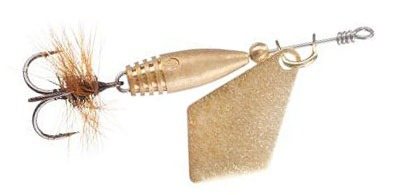
Rebus is a very unusual spinner with a diamond-shaped petal. No matter how strange the shape of this spinner is, after testing it I was convinced that it catches perfectly! It is very good to fish with it in places with weak or no current. I wouldn’t say that this spoon is very good in fairly strong currents.
Rebus weights: 1.1g, 2.1g, 3g.
“Antirebus”

Antirebus is a new product from Maniac. The spinner is essentially the same Rebus, only with a petal rotated 180 degrees. The spinner has not yet fallen into my hands. So, I can’t really say anything. The quality is, naturally, maniacal. I suppose that it is better to use it in slower bodies of water than the classic Rebus. Those. in stagnant bodies of water and in areas with moderate currents. If you have fished with Antirebus from Maniac, write in the comments about your impressions!
"Suprima"
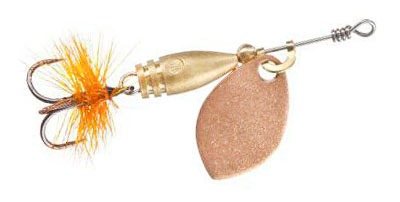
Suprima is a very interesting ultra-light rotating spoon. The shape of the petal is original, medium width, with a pointed end. Suprima is available in only one size - 1.5g. A classic universal option for UL. Very pleased with the use of this type Maniacek. When there is a hunt for peaceful fish, or a small predator is capricious, demanding the smallest, most delicate baits - Suprima is very strong!
Suprima is a very worthy competitor to Mepps two-zeros (Mepps Aglia No. 00 and Mepps Longue No. 00). I consider this triumvirate to be the most popular in the weight range of less than 2g.
With a very serious blade width, this spoon showed itself well not only in calm water, but also on fast mountain rivers and streams.
"Nine"
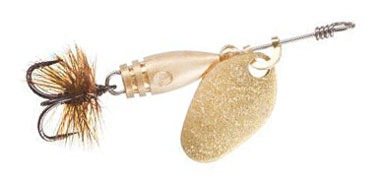
Nine is another purely UL model from Maniac. The spinner comes in a weight of 1.4g. It is good in moderate currents and calm water.
"Six"

Six is an ultra-light turntable with a petal slightly narrower than Suprima’s. Also, a very worthy spinner. Weighs 4g. Thunderstorm of rudd, small trout, etc.
"Egoist"
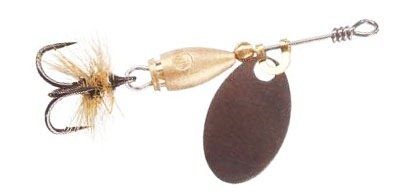
EG-oist is a very small pinwheel, weighing 1.1g. The petal has a very unusual oval shape of medium width. Considering its modest size, the pinwheel is quite stubborn.
“Bolek” and “Lelek”
Bolek and Lelek are the smallest spinners of Maniacka. Pinwheels weigh 1g. Well, find such little ones among the branded spinners! Yes, so that they work, start up so perfectly. The reality is that companies, even those very famous for their spinners, make their different-sized line of lures, only reducing or increasing the proportions of the base model. As a result, small numbers, 00, 000, simply won’t start! In general, they don’t work at all! How this happens with Mepps Black Fury 00, and other examples.
Here, we have absolutely working, unprecedentedly small turntables.
Z.Y. Someone might have the impression that I was advertising these lures, or was somehow interested in promoting them. However, I will disappoint the skeptics. This is wrong. I don’t sell gear, I don’t know Maniac. They just catch!!! Why be silent and shy when you can share with your hobby colleagues an idea, a tool that works, a bait that not only catches, but is, in my opinion, a standard in its class. No more no less!
Here's some of the fresh stuff. They coveted Maniacs, even at a distance of 7,500 km from the place of manufacture.
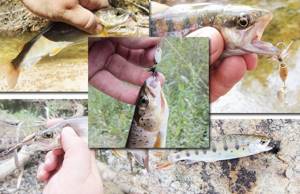
And who forgot about the old: here and there...
Share with your friends:
Category: Tackle Equipment
Tags: Spoons, Spinners, Maniacs, Lures, Tackle, Ultralight
